Your pronation patterns directly impact running efficiency by affecting shock absorption, energy transfer, and injury risk. Proper pronation reduces injury rates by up to 30% through improved force distribution, while real-time monitoring helps you adjust step frequency and footstrike patterns for peak performance. Understanding your pronation type guides footwear selection and enables targeted training adaptations that reduce joint stress and improve biomechanics. The data reveals actionable insights that transform your running form.
How Pronation Mechanics Impact Running Efficiency
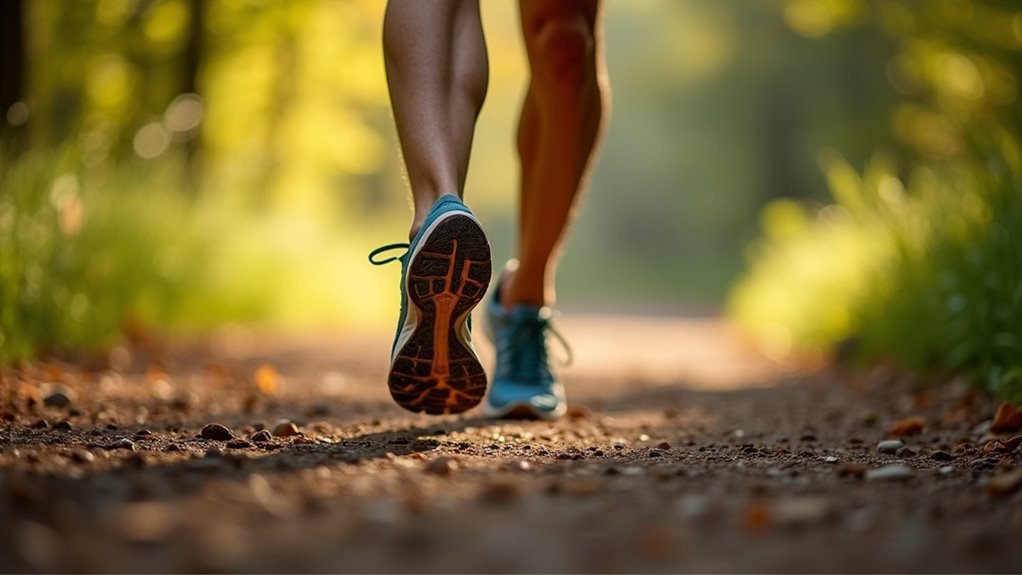
When your foot strikes the ground during each running stride, pronation serves as your body’s natural shock absorption system, distributing impact forces evenly across your foot and lower leg. This biomechanical process lengthens your muscles, enhancing their ability to absorb shock without wasting energy.
You’ll benefit from moderate pronation, which can reduce your injury risk by up to 30% through better force distribution and minimized joint stress.
Pronation also improves your energy transfer during push-off, potentially enhancing your speed and jumping height. Your muscles work more efficiently as pronation allows them to elongate and handle high forces without energy loss. Understanding your pronation type helps you select appropriate footwear since neutral pronators have access to a wider range of shoe options compared to those with overpronation or underpronation patterns.
This natural mechanism stores energy in your foot, leading to more powerful pushes and maintaining muscle endurance by reducing fatigue from repetitive stress.
Measuring Pronation Changes During Athletic Activity
You’ll need reliable assessment tools to accurately capture how your pronation patterns shift throughout your run.
Modern sensor technology, including accelerometers and force-sensitive resistors, can provide real-time data on your foot mechanics during actual athletic activity.
The timing of your post-run measurements also matters greatly, as your gait patterns may continue changing even after you’ve stopped running due to fatigue effects. Static measurements taken while standing fail to capture the dynamic nature of pronation, since motion assessment provides the most accurate evaluation of how your foot actually behaves during running.
Assessment Tools and Methods
Understanding how your feet behave during athletic activity requires proper assessment tools that can capture the dynamic nature of pronation. You’ll find multiple methods available, from simple DIY tests to sophisticated technology that provides real-time data during movement.
The wet test offers a quick starting point – simply step on paper with a wet foot to assess your arch height and basic pronation type. However, for accurate results during actual athletic performance, you’ll need dynamic assessment tools like in-store gait analysis or advanced 3D scanning systems that measure your movement patterns while you’re actually running or walking. Professional gait analysis is typically offered as a free service when purchasing running footwear, making expert assessment accessible for most runners.
- Professional treadmill analysis captures live gait mechanics with integrated sensors and video recording
- 3D pressure mapping reveals force distribution patterns and injury risk areas across your entire foot
- Wearable sensor pods provide continuous monitoring of pronation changes across different terrains and activities
- Shoe wear pattern analysis offers longitudinal data on your habitual pronation tendencies over time
- Static mirror assessments help you observe ankle and arch behavior during simple movement tests
Post-Run Measurement Timing
Since your foot mechanics change dramatically throughout a run, the timing of your pronation measurements becomes critical for capturing accurate data. Immediate post-run assessments reveal the most significant pronation changes, showing increased ankle range of motion and altered foot posture that develops during exercise.
You’ll miss these transient adaptations if you delay measurements, losing valuable insights into your injury risk and performance variations.
Post-run pronation data correlates strongly with your perceived exertion and cardiovascular response, validating the biomechanical changes against physiological stress markers.
These measurements also predict alterations in your knee and ankle joint loads, helping assess injury susceptibility. Early detection of pronation changes enables timely interventions, preventing overuse injuries linked to excessive joint loading and supporting adaptive training protocols. Understanding these biomechanical shifts allows for proper shoe selection that matches your dynamic foot movement patterns rather than static assessments alone.
Injury Risk Assessment Through Pronation Monitoring
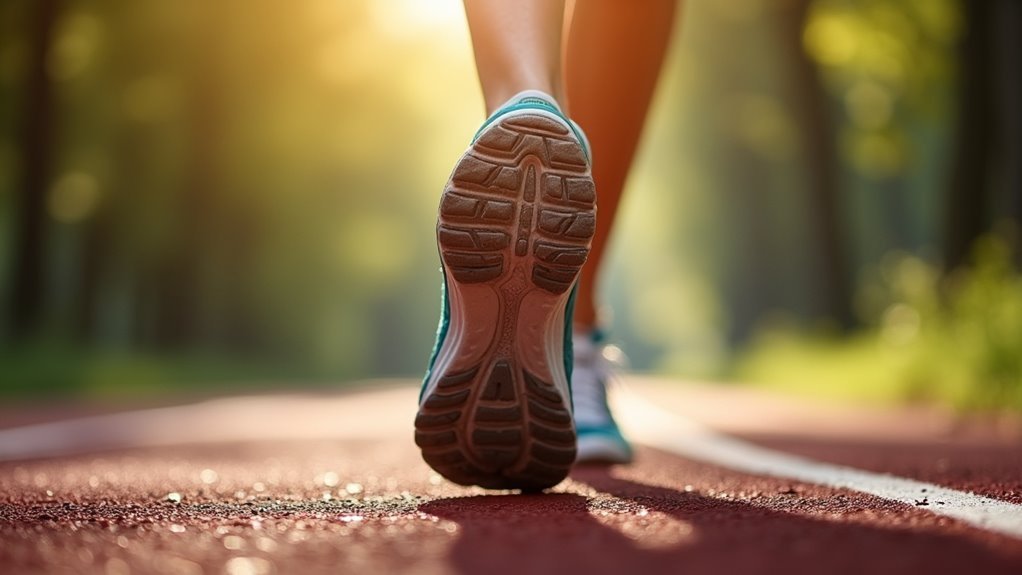
When you’re analyzing your running form, pronation monitoring serves as a critical tool for identifying injury risk before problems develop. Your foot posture directly impacts your vulnerability to specific injuries, particularly if you’re running in standard shoes with excessive pronation patterns.
Research demonstrates that runners with pronated feet face considerably higher injury rates when wearing standard footwear compared to those with neutral foot postures. However, this risk factor doesn’t apply universally—novice runners wearing neutral shoes don’t show increased injury risk from pronation alone.
- Excessive pronation creates higher injury risk specifically for runners using standard shoes
- Motion control shoes effectively reduce pronation-related injury rates through targeted support
- Static foot posture assessment helps predict your injury vulnerability patterns
- Pronated foot types benefit more from specialized footwear than neutral foot types
- Professional evaluation identifies your specific pronation-related risk factors
Tracking your running data becomes essential during 6-month follow-up periods to establish clear patterns between your foot mechanics and any developing injury symptoms.
Wearable Technology for Real-Time Pronation Tracking
You can now track your pronation patterns in real-time using wearable devices that combine accelerometers, gyroscopes, and pressure sensors to capture detailed biomechanical data.
These devices offer immediate feedback on your running form, but you’ll need to take into account their accuracy limitations compared to laboratory-grade equipment. Advanced footpods with 500Hz sampling rates can record every step during your runs, providing comprehensive data collection for detailed gait analysis.
Your challenge lies in integrating data from multiple sensors and platforms to create an all-encompassing picture of your running mechanics that translates into actionable performance improvements.
Real-Time Monitoring Benefits
While traditional gait analysis required lab visits and expensive equipment, modern wearable technology now puts real-time pronation monitoring directly on your feet during actual runs.
You’ll receive instant feedback on your footstrike patterns, pronation velocity, and load distribution, allowing immediate technique adjustments mid-stride. This continuous data stream helps you enhance your running mechanics on the spot, reducing injury risk and improving performance efficiency. Excessive pronation has been directly linked to common running injuries like plantar fasciitis and shin splints, making real-time monitoring crucial for injury prevention.
- Dynamic gait corrections – Adjust step frequency and footstrike patterns in real-time based on biomechanical feedback
- Injury prevention alerts – Identify dangerous asymmetries or excessive pronation before they cause chronic problems
- Performance enhancement – Improve running economy through immediate technique refinements and load distribution improvements
- Fatigue adaptation – Maintain ideal movement patterns as terrain changes and exhaustion sets in
- Personalized coaching – Receive objective, measurable guidance tailored to your specific biomechanical patterns and injury history
Device Accuracy Considerations
Although real-time pronation monitoring offers compelling benefits, the accuracy of wearable devices varies greatly depending on their design, placement, and calibration.
Foot-mounted wearables like NURVV Run insoles with multiple sensors accurately track core metrics including footstrike patterns and ground contact time. However, you’ll find that joint kinematics measurements show conflicting reliability across studies.
Proper device positioning is essential—placement on your insole versus shoe versus shank notably affects data quality. You’ll need user-specific calibration to avoid misclassification of your pronation patterns, and different footwear can alter sensor readings.
While advanced metrics like pronation excursion offer deeper biomechanical insights, they’re more sensitive to measurement errors, with some devices showing up to 20% variance in certain metrics. Validating device accuracy through third-party research helps ensure you’re making training decisions based on reliable measurements rather than potentially misleading data.
Data Integration Strategies
Real-time pronation tracking relies on sophisticated data integration strategies that seamlessly combine multiple sensor inputs to deliver actionable insights during your runs.
Your wearable devices use wireless transmission protocols like Bluetooth and Wi-Fi to send pronation metrics instantly to mobile apps or cloud platforms.
Machine learning algorithms continuously process raw sensor data, classifying your running motions and detecting pronation anomalies on the fly.
Multi-sensor fusion combines kinetic, kinematic, and spatial data from foot pods and hip mounts, creating thorough pronation profiles that reveal your complete gait picture. Advanced devices utilize 3D movement analysis to capture the complete range of pronation patterns throughout your stride cycle.
- Live foot pressure maps show real-time pressure distribution changes across strike phases
- Pronation angle visualization enables instant form correction during active runs
- Cloud-based longitudinal tracking monitors pronation trends over weeks and months
- Synchronized multi-sensor streams prevent data loss through robust connectivity algorithms
- Personalized analytics integrate pronation with cadence and ground contact metrics
Footwear Selection Based on Pronation Patterns
Understanding your pronation pattern becomes the foundation for selecting running shoes that’ll enhance both performance and injury prevention.
Proper pronation assessment serves as your roadmap to finding running shoes that optimize performance while preventing costly injuries.
You’ll need to assess your personal pronation type through wear pattern analysis or professional gait assessment.
If you’re an overpronator showing medial shoe wear, choose motion control footwear with harder midsole material along the arch, supportive heel counters, and rearfoot posting.
These features limit excessive eversion and midfoot collapse while reducing knee injury risk through decreased internal tibial rotation.
Neutral runners should select neutral shoes with balanced support, while supinators need cushioned footwear with extra lateral padding to accommodate outward rolling patterns.
Adding arch support insoles can further enhance biomechanical efficiency and provide additional comfort regardless of your pronation type.
Regularly monitor your shoe wear patterns, as pronation habits can shift over time, requiring footwear adjustments to maintain peak performance and joint stability.
Training Adaptations Using Pronation Performance Data
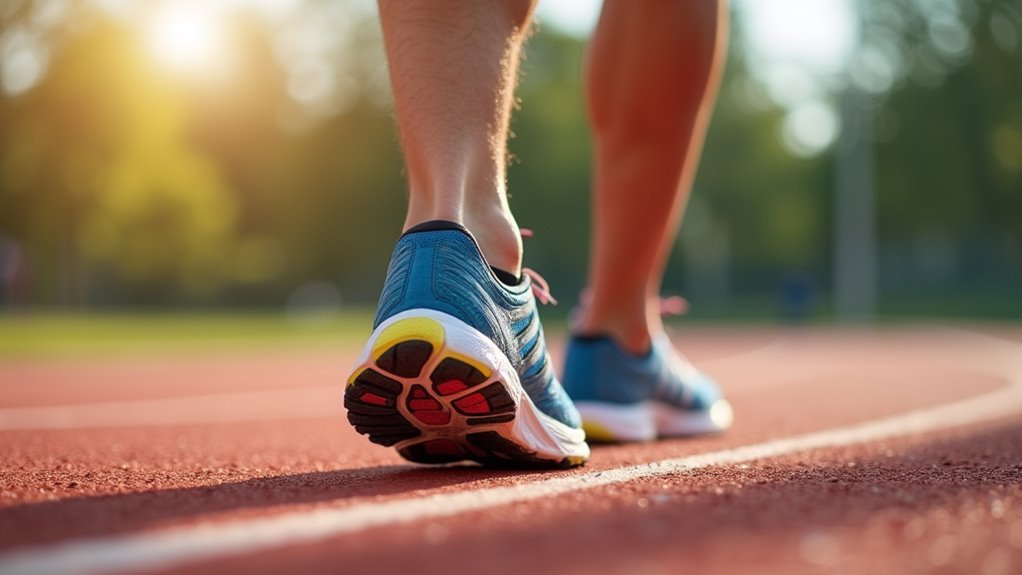
Once you’ve identified your pronation patterns through gait analysis, you can leverage this biomechanical data to make targeted training modifications that’ll enhance performance while reducing injury risk.
Your pronation pattern directly affects impact forces and foot inclination angles, making this information essential for customizing your approach.
Feedback-based gait retraining helps alter movement patterns to improve lower limb biomechanics. If you’re dealing with over-pronation, specific interventions can reduce unnecessary stress on your joints while enhancing running efficiency. Reducing your foot progression angle and lateralizing center of pressure can effectively decrease problematic foot pronation patterns.
Key Training Adaptations Based on Pronation Data:
- Increase step cadence by 5% to reduce peak braking forces by up to 11.4%
- Implement forefoot strike training to increase foot arch and reduce pronation
- Adjust step width strategically to minimize excessive foot pronation
- Use tibial acceleration reduction techniques for improved biomechanics
- Apply dynamic plantar support enhancement through targeted retraining
Frequently Asked Questions
Can Runners Completely Eliminate Pronation Through Training or Exercises?
You can’t completely eliminate pronation through training since some pronation’s naturally necessary for shock absorption. However, you’ll greatly reduce excessive pronation and improve biomechanics through targeted exercises and gait retraining.
How Often Should Recreational Runners Get Their Pronation Professionally Assessed?
You should get your pronation professionally assessed every 6-12 months, or sooner if you’re increasing mileage, changing footwear, experiencing pain, or noticing gait changes during training.
Does Age Affect How Much a Runner’s Pronation Changes Over Time?
Yes, you’ll experience more pronation changes as you age. Your joints lose mobility, muscle strength decreases, and loading rates increase, causing your foot mechanics to shift more dramatically over time.
Are There Specific Warm-Up Routines That Help Control Excessive Pronation?
You can control excessive pronation through targeted warm-ups including ankle circles, calf raises, single-leg balances, and toe spreads. These exercises strengthen stabilizing muscles and improve foot mechanics before running.
Can Weather Conditions or Running Surface Temperature Influence Pronation Patterns?
Weather conditions can influence your pronation patterns through biomechanical adaptations. Hot temperatures and high humidity affect your running mechanics, while different surface temperatures may alter your foot strike and pronation excursion during runs.
In Summary
You’ll transform your running performance by understanding your pronation data. You can optimize your efficiency, prevent injuries, and select the right footwear when you track how your feet move during each stride. With today’s wearable technology, you’re able to monitor real-time changes and adapt your training accordingly. Don’t overlook this biomechanical insight—it’s the key to releasing your potential and staying injury-free throughout your running journey.

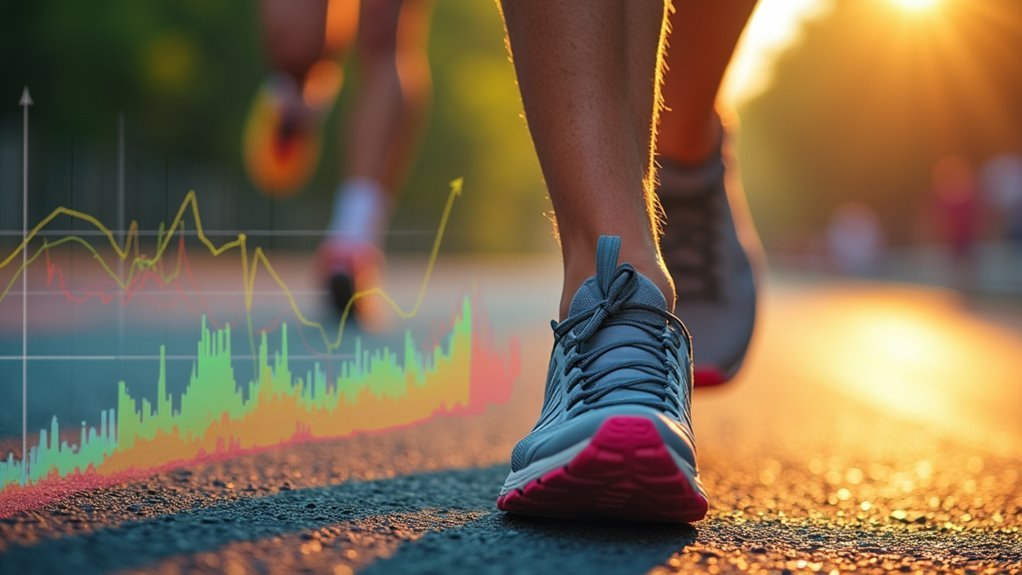

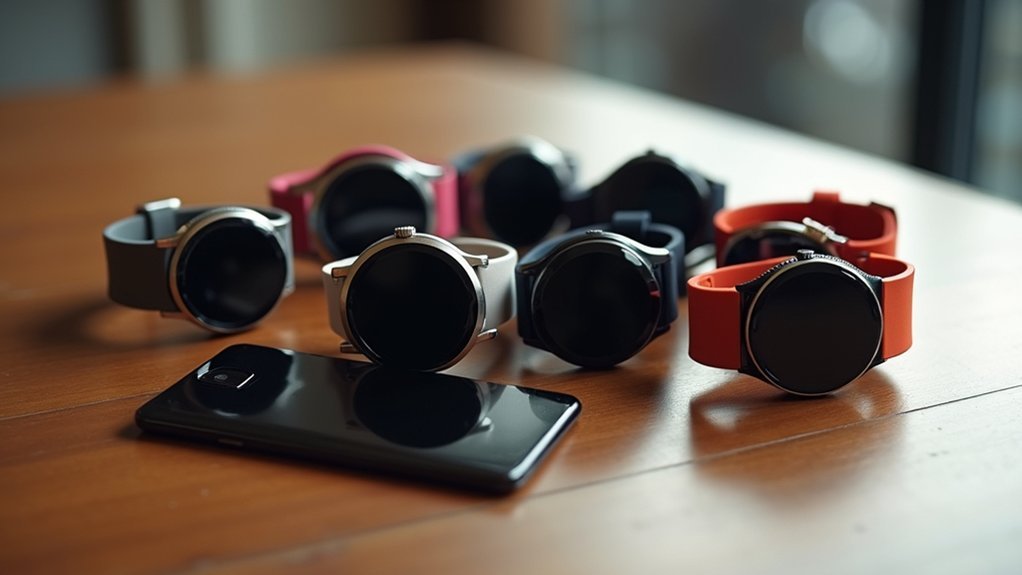

Leave a Reply